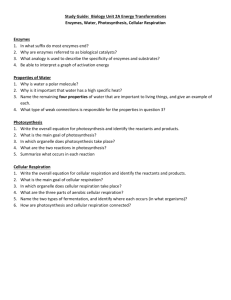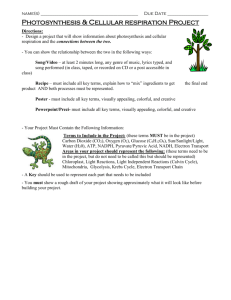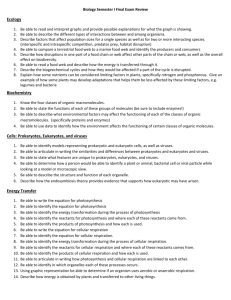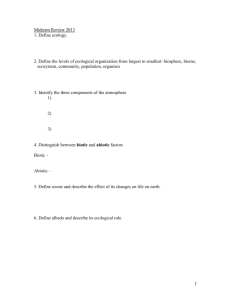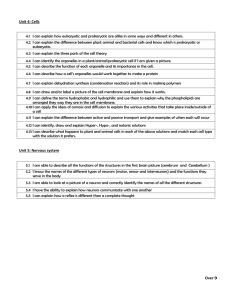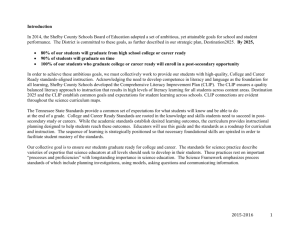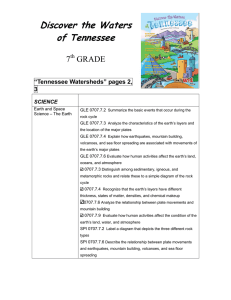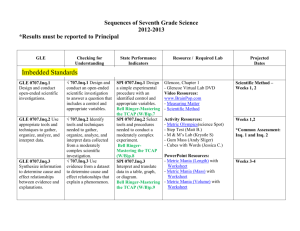Science Curriculum Maps are provided
advertisement
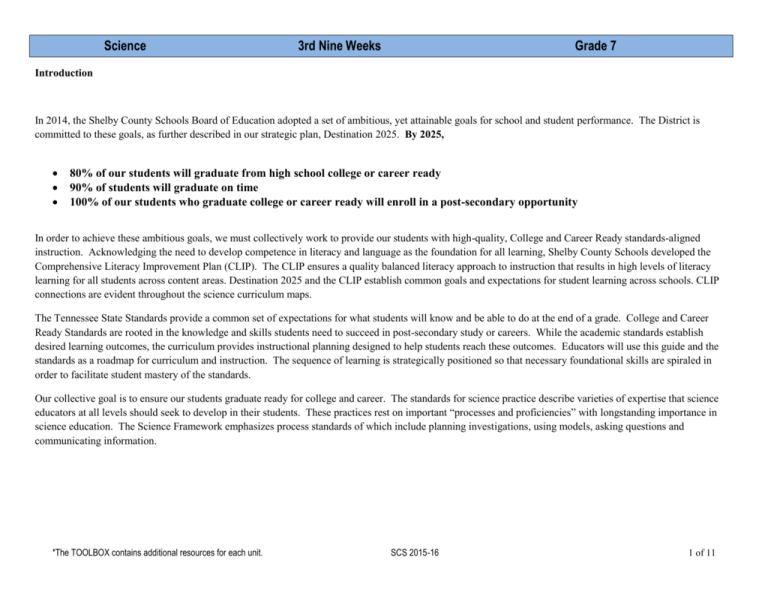
Science 3rd Nine Weeks Grade 7 Introduction In 2014, the Shelby County Schools Board of Education adopted a set of ambitious, yet attainable goals for school and student performance. The District is committed to these goals, as further described in our strategic plan, Destination 2025. By 2025, 80% of our students will graduate from high school college or career ready 90% of students will graduate on time 100% of our students who graduate college or career ready will enroll in a post-secondary opportunity In order to achieve these ambitious goals, we must collectively work to provide our students with high-quality, College and Career Ready standards-aligned instruction. Acknowledging the need to develop competence in literacy and language as the foundation for all learning, Shelby County Schools developed the Comprehensive Literacy Improvement Plan (CLIP). The CLIP ensures a quality balanced literacy approach to instruction that results in high levels of literacy learning for all students across content areas. Destination 2025 and the CLIP establish common goals and expectations for student learning across schools. CLIP connections are evident throughout the science curriculum maps. The Tennessee State Standards provide a common set of expectations for what students will know and be able to do at the end of a grade. College and Career Ready Standards are rooted in the knowledge and skills students need to succeed in post-secondary study or careers. While the academic standards establish desired learning outcomes, the curriculum provides instructional planning designed to help students reach these outcomes. Educators will use this guide and the standards as a roadmap for curriculum and instruction. The sequence of learning is strategically positioned so that necessary foundational skills are spiraled in order to facilitate student mastery of the standards. Our collective goal is to ensure our students graduate ready for college and career. The standards for science practice describe varieties of expertise that science educators at all levels should seek to develop in their students. These practices rest on important “processes and proficiencies” with longstanding importance in science education. The Science Framework emphasizes process standards of which include planning investigations, using models, asking questions and communicating information. *The TOOLBOX contains additional resources for each unit. SCS 2015-16 1 of 11 Science Construct explanations and design solution Obtain, evaluate, and communicate information Engage in argument 3rd Nine Weeks Grade 7 Ask questions and define problems Patterns Develop and use models Practices in Science Use math, technology, and computational thinking Plan and carry out investigations Stability and change Cross Cutting Concepts Cause and Effect Analyze and interpret data Energy and matter Systems and system models Crosscutting concepts have value because they provide students with connections and intellectual tools that are related across the differing areas of disciplinary content and can enrich their application of practices and their understanding of core ideas. Throughout the year, students should continue to develop proficiency with the eight science practices. Crosscutting concepts can help students better understand core ideas in science and engineering. When students encounter new phenomena, whether in a science lab, field trip, or on their own, they need mental tools to help engage in and come to understand the phenomena from a scientific point of view. Familiarity with crosscutting concepts can provide that perspective. A next step might be to simplify the phenomenon by thinking of it as a system and modeling its components and how they interact. In some cases it would be useful to study how energy and matter flow through the system, or to study how structure affects function (or malfunction). These preliminary studies may suggest explanations for the phenomena, which could be checked by predicting patterns that might emerge if the explanation is correct, and matching those predictions with those observed in the real world. *The TOOLBOX contains additional resources for each unit. SCS 2015-16 2 of 11 Science 3rd Nine Weeks Grade 7 Science Curriculum Maps This curriculum map is designed to help teachers make effective decisions about what science content to teach so that, our students will reach Destination 2025. To reach our collective student achievement goals, we know that teachers must change their instructional practice in alignment with the three College and Career Ready shifts in instruction for science. To ensure that all student will be taught science content and processes in a comprehensive, consistent, and coherent manner, Science Curriculum Maps are provided. Foundation texts for the maps include Shelby County Schools Framework for Standards Based Curriculum, Science Curriculum Frameworks-K-12 (State of Tennessee Board of Education, and National Science Education Standards). Teachers function most effectively and students learn best within an “aligned” curriculum delivery system. An aligned system begins with a concerted effort to implement the state curriculum frameworks. Many districts have developed curriculum guides built around these frameworks to ensure that what is taught in particular grades and courses is closely linked with student Learning Expectations found in the state standards. Classroom teachers use these locally-generated curriculum guides to plan and implement their individual grade or course Pacing Guides. Expectations for student performance are clear and carefully tied to daily instructional events and classroom assessment practices. In theory, a fully aligned system closes the loop between state standards and student learning. Additionally, a coherent instructional/assessment system offers the potential for heightening student learning as reflected by their performance on state-mandated standardized tests. Our collective goal is to ensure our students graduate ready for college and career. Most of the elements found in the state Curriculum Frameworks were incorporated into the curriculum mapping materials prepared by Shelby County Schools. Additional features were included to add clarity and to offer avenues that could assist teacher in developing grade level lessons. A district-wide, K-12, standards-based curriculum is implemented in science. This curriculum is articulated in the form of individual SCS curriculum maps for each grade and subject. These SCS curriculum maps enable the district to implement a single curriculum that emphasizes specific standards. Since Shelby County has a high rate of mobility among the student population, the SCS curriculum maps ensure that all students receive the same program of high-level instructional content and academic expectations, regardless of which school they attend. The utilization of a district-wide standards-based curricular program ensures that students in SCS are engaged in hands-on inquiry based activities as teachers implement the curriculum maps. *The TOOLBOX contains additional resources for each unit. SCS 2015-16 3 of 11 Science State Standards 3rd Nine Weeks Embedded Standards Grade 7 Learning Outcomes Resources CLIP Connections Unit 3.1 - Cells, 5 Weeks GLE 0707.1.1 Make observations and describe the structure and function of organelles found in plant and animal cells. GLE 0707.1.4 Illustrate how cell division occurs in sequential stages to maintain the chromosome number of a species. GLE 0707.1.5 Observe and explain how materials move through simple diffusion. GLE 0707.Inq.1 Design and conduct open-ended scientific investigations. GLE 0707.Inq.2 Use appropriate tools and techniques to gather, organize, analyze, and interpret data. GLE 0707.Inq.5 Communicate scientific understand using descriptions, explanations and models Generate evidence from text to explain and support the cell theory. Observe and identify organelles of plant and animal cells. Analyze data from an investigation into the limit of cell size. Predict the movement of materials into and out of cells by diffusion. Sequence a series of diagrams, models, descriptions and/or photographs that depict chromosome movement during cell division Tennessee Holt Science and Technology TE, Chapter 2, Section 1: The Diversity of Cells and Section 2: Eukaryotic Cells, p. 46-63 Chapter 3, Section 3: The Cell Cycle, pp.86-89 Glencoe Tennessee Science Grade 7 TWE, Chapter 2, Section 1: Cell Structure, p 44-57 Chapter 3, Section 2: Moving Cellular Materials, p. 80-85 Chapter 6, Section 1: Cell Division and Mitosis, p. 174-180 NGSS Practice 2: Developing and using models NGSS Practice 4: Analyzing and interpreting data NGSS Practice 8: Obtaining, evaluating and communicating information. A Glencoe workbook, aligned with State Performance Indicators for 7th grade science, which is designed to assess student mastery. Included are formative assessments, student activities, and more. This is an excellent resource. Literacy Task: Introduce a topic clearly, previewing what is to follow; organize ideas, concepts, and classification, comparison/contrast, and cause/effect; include formatting, graphics, and multimedia when useful to aiding comprehension. Science Activity A Day: Chapter 6 pg. 77-79 Literacy Task: Support claims with logical reasoning and relevant, accurate data and evidence that demonstrate an understanding of the topic or text, using credible sources. Pink Palace Museum Field Trips Exhibits: Small Worlds Labs: Cell Structure and microscope techniques, Mitosis and microscope techniques Suitcases: Microscopes and cells Passports: Giant Animal and Plant *The TOOLBOX contains additional resources for each unit. Academic vocabulary: cell, cell membrane, organelle, nucleus, prokaryote, eukaryote, cell wall, mitochondrion SCS 2015-16 Task: Allow students to write a storybook on cells and their organelles. http://askabiologist.asu.edu/content/cel l-parts 4 of 11 Science 3rd Nine Weeks Grade 7 cell models, Animal and plant cell models (4 sets of 2 models), Compound light microscope, 10 Microslide Viewers w/cells slide strips, Animal cell mitosis models Task: Provide text dependent questions; Reading Comprehension Passage: Cell Division Through Mitosis (Includes an online cloze activity.) http://education.jlab.org/reading/mitosi s_01.html Task: Summarize main ideas Vocabulary cloze activities that reinforce student understanding of cellular structures and organelles. Great resource for small group station rotations. (Pages 3-6) http://www.mhschool.com/instructional _materials/ca/pdf/sc08_5_se.pdf Unit 3.2: Levels of Organization, 2 Weeks GLE 0707.1.2 Summarize how the different levels of organization are integrated within living systems. GLE 0707.1.3 Describe the function of different organ systems and how collectively they enable complex multicellular organisms to survive. GLE 0707.Inq.2 Use appropriate tools and techniques to gather, organize, analyze, and interpret data. GLE 0707.Inq.5 Communicate scientific understand using descriptions, explanations and models. GLE 0707.T/E.4 Describe and explain adaptive and assistive bioengineered products. Explain the relationships that exist among cells, tissues, organs, and organ systems. Summarize how the needs of organisms at the cellular level for food, air, and waste removal are met by tissues and organs. Relate the structures to the functions of various cells, tissues, organs, and systems. Compare bioengineered products to the organ or organ system they replace. Tennessee Holt Science and Technology TE, Chapter 2, Section 3: The Organization of Living Things, p. 99, 64-67 Chapter 8, Section 1: Body Organization and Section 2: The Skeletal System and Section 3: The Muscular System and Section 4: The Integumentary System, p. 218-221 Academic vocabulary: tissue, organ, organ system, organism, structure, function Glencoe Tennessee Science Grade 7 TWE, Chapter 3, Section 1: Chemistry of Life TE p. 72 - 79 Chapter 2, Section 1: Cell Structure, p .51 Literacy Task: Introduce a topic clearly, previewing what is to follow; organize ideas, concepts, and classification, comparison/contrast, and cause/effect; include formatting, graphics, and multimedia when useful to aiding comprehension. A Glencoe workbook, aligned with State Performance Indicators for 7th *The TOOLBOX contains additional resources for each unit. SCS 2015-16 NGSS Practice 8: Obtaining, evaluating and communicating information. 5 of 11 Science 3rd Nine Weeks Grade 7 grade science, which is designed to assess student mastery. Included are formative assessments, student activities, and more. This is an excellent resource. Science Activity A Day: Chapter 6 pg. 80 Task: Complete the concept map Vocabulary cloze activities that reinforce student understanding of the levels of organization/organization of life. Great resource for small group station rotations. (Pages 7-10 and 4146) http://www.mhschool.com/instructional _materials/ca/pdf/sc08_5_se.pdf Unit 3.3: Flow of Matter & Energy, 2 Weeks GLE 0707.3.1 Distinguish between the basic features of photosynthesis and respiration GLE 0707.Inq.2 Use appropriate tools and techniques to gather, organize, analyze, and interpret data. GLE 0707.3.2 Investigate the exchange of oxygen and carbon dioxide between living things and the environment. GLE 0707.Inq.5 Communicate scientific understanding using descriptions, explanations, and models. Model the pathways of water, oxygen, and carbon dioxide through a plant. Compare structures that animals use to obtain oxygen. Associate photosynthesis and respiration with appropriate cell organelles. Analyze experimental data to determine the reactants and products of photosynthesis and cellular respiration. Describe the energy transformation that occurs during photosynthesis and during cellular respiration. Interpret a diagram of the carbon-oxygen cycle. *The TOOLBOX contains additional resources for each unit. Tennessee Holt Science and Technology TE, Chapter 3, Section 1: Exchange with the Environment, p. 76-81, Section 2: Cell Energy, p. 8285 Chapter 7, Section 1: Photosynthesis, p. 184-187 Academic vocabulary: diffusion, osmosis, passive transport, active transport, endocytosis, exocytosis, photosynthesis, cellular respiration Glencoe Tennessee Science Grade 7 TWE, Chapter 3, Section 3: Energy for Life, p 87-91 NGSS Practice 6: Constructing explanations (for science) and designing solutions (for engineering) A Glencoe workbook, aligned with State Performance Indicators for 7th grade science, which is designed to assess student mastery. Included are formative assessments, student activities, and more. This is an excellent resource. NGSS Practice 7: Engaging in argument from evidence. Science Activity A Day: Photosynthesis pg. 88 SCS 2015-16 NGSS Practice 4: Analyzing and interpreting data. Literacy Task: Integrate quantitative or technical information expressed in words in a text with a version of that information expressed visually. Literacy Task: Write informative/explanatory texts, including the narration of historical events, scientific procedures/experiments, or technical processes. 6 of 11 Science 3rd Nine Weeks Grade 7 Task: Write an essay describing the process of photosynthesis using claims and evidence from variety of sources. A lesson that engages students in essay writing to describe the process of photosynthesis (using claims and evidence from a variety of sources). http://betterlesson.com/lesson/628541/ photosynthesis-claim-and-evidence *The TOOLBOX contains additional resources for each unit. SCS 2015-16 7 of 11 Science 3rd Nine Weeks Grade 7 TOOLBOX Unit 3.1 - Cells, 5 Weeks With this lesson plan, students will be able to describe the characteristics of living organisms, describe and identify the parts of an animal cell, and describe and identify the parts of a plant cell. https://www.bemidjistate.edu/academics/departments/science/k12-science-units/Animal-cell-unit.pdf Plans This lesson plan prepares students to develop and use a model to describe the function of a cell and describe ways parts of cells contribute to the function of the cell. Included, is a unit plan students keep in their binders to assess their own learning. http://betterlesson.com/lesson/638622/insane-in-the-membrane This booklet has a wealth of information about the parts and functions of cells in a comic strip format. http://www.indiana.edu/~istdept/R521/student_workbook.pdf Background for Teachers Khan Academy Video - Osmosis and Diffusion. http://www.khanacademy.org/science/biology/cell-division/v/diffusion-and-osmosis Khan Academy Video - Phases of Mitosis. http://www.khanacademy.org/science/biology/cell-division/v/phases-of-mitosis This interactive website allows students to label the steps of mitosis. It can be used individually, whole group, or small group with your interactive whiteboard. http://www.neok12.com/diagram/Cell-Division-01.htm Osmosis Lab: How a cell reacts when placed in different solutions. http://edtech2.boisestate.edu/pattymcginnis/592/Files/506%20Lesson%202%20Egg%20Osmosis%20Lab.pdf Student Activities This interactive website allow students to label the organelles of an animal cell. http://www.sheppardsoftware.com/health/anatomy/cell/cell_game.htm This interactive website allows students to label the organelles of a plant cell. http://www.purposegames.com/game/animal-cell-organelles-labeling-interactivegame An interactive quiz about plant and animal cell structures that provides students with immediate feedback prior to progressing to the next question. http://www.proprofs.com/quiz-school/story.php?title=3rd-block-group-2_1 Inside A Cell - This online tool is an interactive 3D view of the cell. It allows you a close view of each cell type and a description of the organelles. http://www.cellsalive.com/cells/cell_model.htm Other Resources Great cell membrane animation. http://www.teachersdomain.org/asset/tdc02_int_membraneweb/ Great Osmosis animation that gives your students a visual of what is happening to ions during a hypotonic, hypertonic, and isotonic solution. http://www.nclark.net/osmosisPocus.gif *The TOOLBOX contains additional resources for each unit. SCS 2015-16 8 of 11 Science 3rd Nine Weeks Grade 7 TOOLBOX A library of plant and animal cell websites. http://www.kathimitchell.com/cells.html Labs, handouts, and interactive games/activities on cell structure, reproduction, and process: http://www.biologycorner.com/lesson-plans/cells/ A link to multiple osmosis and diffusion resources (tutorials, student activities, and articles). http://www.internet4classrooms.com/grade_level_help/life_science_simple_diffusion_seventh_7th_grade_science.htm Unit 3.2: Levels of Organization, 2 Weeks In this lesson plan, students will observe the organization of life through classification cards while designing a foldable that describes the hierarchal system from lower level to more complex organisms. http://www.pdesas.org/module/content/resources/14035/view.ashx Plans Background for Teachers Levels of Organization Flipped: A lesson plan to help students understand the various levels of structural organization within the human body. http://betterlesson.com/lesson/634234/levels-of-organization-flipped This PowerPoint teaches the levels of organization from cells to the organ systems. http://www.slideshare.net/MissWander/powerpoint-43-the-organization-ofliving-things Information along with pictures of the levels of organization: http://utahscience.oremjr.alpine.k12.ut.us/sciber00/7th/cells/sciber/levelorg.htm The human body is one of the greatest machines of all time. It is made up of many systems that interact and enable us to move, eat, and self-maintain. In this Web Quest, you will take a journey to the inside of the human body and research the inner workings of the major body systems that work together to keep all of us alive. http://zunal.com/webquest.php?w=176054 Student Activities Students can use the Body Organization and Structure online quiz to check their understanding. http://go.hrw.com/activities/frameset.html?main=2280.html An interactive that allows students to match organs with their respective organ systems - http://sciencenetlinks.com/interactives/systems.html This brief interactive video explores the similarities that plants and animals share, as they are organized from cell to system. A quiz to check for understanding is included. http://www.bbc.co.uk/bitesize/ks3/science/organisms_behaviour_health/cells_systems/activity/ This site summarizes the levels of organization. http://www.scsc.k12.in.us/SMS/Teachers/Martin/replacelevelsoforganization.htm Other Resources Pete's PowerPoint Station offers teachers a wide variety of ready-made PowerPoint for use in classrooms. This link provides you with all the human body PowerPoint’s. From the Circulatory system to the Integumentary system, you will find a PowerPoint for the body system you are looking for. All power points are capable of being downloaded and are able to be reformatted for your class. http://science.pppst.com/humanbody/index.html The American Association for the Advancement of Science - This is a list of key ideas related to Human Body Systems. For each key idea, you will find a list of *The TOOLBOX contains additional resources for each unit. SCS 2015-16 9 of 11 Science 3rd Nine Weeks Grade 7 TOOLBOX sub-ideas, a list of items, results from the AAAS field-testing, and a list of student misconceptions. Question items provided can be used to assess student understanding. http://assessment.aaas.org/topics/BF#/ This site covers the organization levels of the human body using educational videos and background information. http://www.ck12.org/biology/Organization-ofthe-Human-Body/ Levels of Organization video. https://www.youtube.com/watch?v=ZRFykdf4kDc Unit 3.3: Flow of Matter & Energy, 2 Weeks A lesson in which students use computer simulations to model and differentiate photosynthesis and cellular respiration. http://betterlesson.com/lesson/635947/photosynthesis-and-cellular-respiration A lesson in which students study how the respiratory system of a frog changes during its life cycle. http://www.pdesas.org/module/content/resources/14007/view.ashx Plans Lesson Plan: The student will be able to apply the process of diffusion/osmosis to explain both science and everyday phenomena. http://betterlesson.com/lesson/631307/it-s-getting-crowded-let-s-move-osmosis-and-diffusion A lesson describing the use of lettuce leaves to model stomata can be found using the following link: http://www.carolinacurriculum.com/premium_content/eBooks/Organisms+Macro+Micro/pdfs/Lesson_10.pdf Background for Teachers Student Activities This website explains how photosynthesis and cellular respiration are mutually dependent processes. http://www.ehow.com/facts_5900540_photosynthesisrespiration-mutually-dependent-processes_.html This article will give you information on the process of photosynthesis and cellular respiration. It discusses how they are related and describes their differences. http://www.buzzle.com/articles/photosynthesis-and-cellular-respiration.html Students investigate the effect of various environmental factors on the rates of photosynthesis and/or cellular respiration, using live organisms or simulations. An experiment using yeast is described at the following website: http://www.carolinacurriculum.com/premium_content/eBooks/Organisms+Macro+Micro/pdfs/Lesson_15.pdf An animated tutorial that explains and illustrates the process of photosynthesis. An excellent introductory or reinforcement resource. http://www.harcourtschool.com/activity/science_up_close/311/deploy/interface.swf Other Resources An excellent cellular respiration animation contrasting cellular respiration and photosynthesis. http://www.sumanasinc.com/webcontent/animations/content/cellularrespiration.html *The TOOLBOX contains additional resources for each unit. SCS 2015-16 10 of 11 Science 3rd Nine Weeks Grade 7 TOOLBOX An interactive game on the carbon dioxide-oxygen cycle can be found at the following website: http://www.windows2universe.org/earth/climate/carbon_cycle.html The American Association for the Advancement of Science - This is a list of key ideas related to Matter and Energy in Living Systems. For each key idea, you will find a list of sub-ideas, a list of items, results from the AAAS field-testing, and a list of student misconceptions. Question items provided can be used to assess student understanding. http://assessment.aaas.org/topics/ME#/ Vocabulary cloze activities that reinforce student understanding of the relationship between photosynthesis and cellular respiration. Great resource for small group station rotations. (Pages 31-34) http://www.mhschool.com/instructional_materials/ca/pdf/sc08_5_se.pdf *The TOOLBOX contains additional resources for each unit. SCS 2015-16 11 of 11



